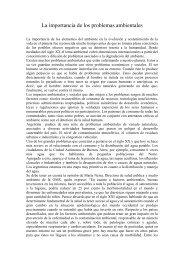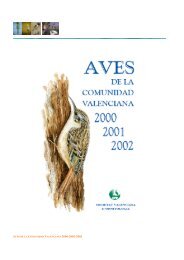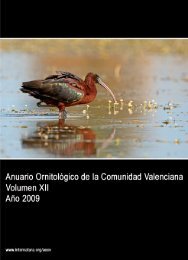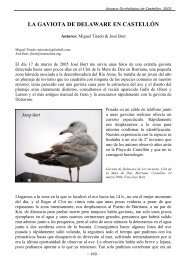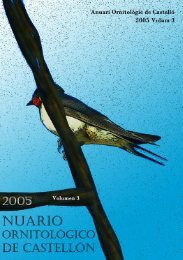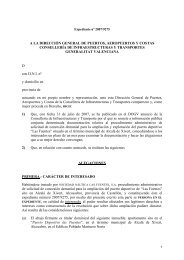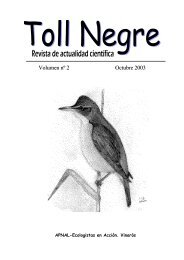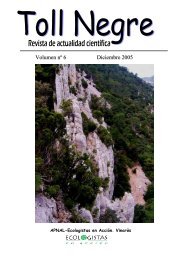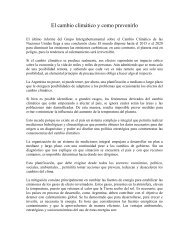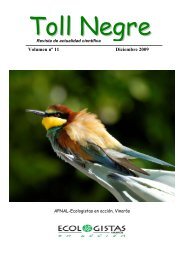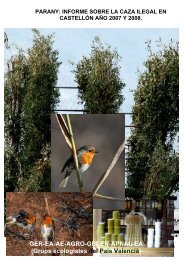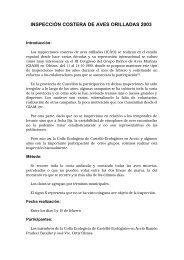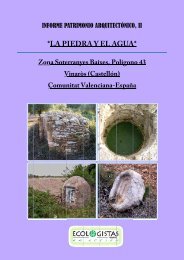ANUARIO ORNITOLÃGICO DE CASTELLÃN 2007 - InterNatura
ANUARIO ORNITOLÃGICO DE CASTELLÃN 2007 - InterNatura
ANUARIO ORNITOLÃGICO DE CASTELLÃN 2007 - InterNatura
Create successful ePaper yourself
Turn your PDF publications into a flip-book with our unique Google optimized e-Paper software.
Anuario Ornitológico de Castellón. <strong>2007</strong><br />
I<strong>DE</strong>NTIFYING POTENTIALLY NESTING HABITAT FOR<br />
GOL<strong>DE</strong>N EAGLES (AQUILA CHRYSAETOS) APPLIED TO<br />
IMPORTANT BIRD AREAS <strong>DE</strong>SIGN.<br />
Autor: LÓPEZ-LÓPEZ, P., GARCÍA-RIPOLLÉS, C., SOUTULLO, A., CADAHÍA, L. &<br />
URIOS, V.<br />
Datos de contacto: Pascual.Lopez@uv.es<br />
Tipo de comunicación: Artículo científico<br />
Referencia: Animal Conservation 10(2): 208-218<br />
Fecha publicación: <strong>2007</strong><br />
Abstract: Geographic Information Systems (GIS) based habitat-suitability modelling is becoming<br />
an essential tool in conservation biology. A multi-scale approach has been proposed as a<br />
particularly useful way to identify different factors affecting habitat preferences. In this paper we<br />
developed predictive models of potentially suitable habitat for Golden eagles Aquila chrysaetos at<br />
three spatial scales in a representative Mediterranean area on the Iberian Peninsula. We used<br />
logistic regression through a Generalized Linear Model (GLM) to model Golden eagle breeding<br />
habitat preferences. The best occurrence GLM models were those that involved topographic<br />
factors as independent predictors. Golden eagles seemed to prefer rugged and higher places of the<br />
study area for nesting. Climatic factors identified cold temperatures in January and temperate ones<br />
in July as best predictors of eagles’ occurrence. This was also higher in places with less<br />
agricultural areas and higher surface of pine forests. The distribution of potentially suitable area<br />
matches the distribution of mountain ranges, mainly in inner sectors of the study area. In contrast,<br />
potentially suitable nest sites in coastland areas remain unoccupied by Golden eagles. Avoidance<br />
of coastland places for nesting may be due to the synergistic effects of human avoidance and the<br />
occurrence of potential competitors, like the endangered Bonelli’s eagle Hieraaetus fasciatus.<br />
When mapped at fine spatial resolution, the best GLM model identified large areas that fall outside<br />
the current network of protected areas. We therefore propose three new Important Bird Areas<br />
(IBAs) for the region.<br />
POPULATION SIZE, BREEDING PERFORMANCE AND<br />
TERRITORY QUALITY OF BONELLI’S EAGLE (HIERAAETUS<br />
FASCIATUS) IN EASTERN IBERIAN PENINSULA.<br />
Autor: LÓPEZ-LÓPEZ, P., GARCÍA-RIPOLLÉS, C. & URIOS, V.<br />
Datos de contacto: Pascual.Lopez@uv.es<br />
Tipo de comunicación: Artículo científico<br />
Referencia: Bird Study 54: 335–342<br />
Fecha publicación: <strong>2007</strong><br />
Abstract: Capsule A five-year monitoring study is described of overall population stability and<br />
differential reproductive success in relation to habitat heterogeneity. Aims To assess the effect of<br />
the altitude and orientation on laying date and breeding performance, and analyse the effect of<br />
territory quality as a likely factor that could be regulating the population. Methods We monitored a<br />
population of 28–33 pairs, from 2002 to 2006, counting a total of 131 breeding attempts. Results<br />
Territories located at lower altitude showed higher mean fecundity than those located at higher<br />
- 216 -



